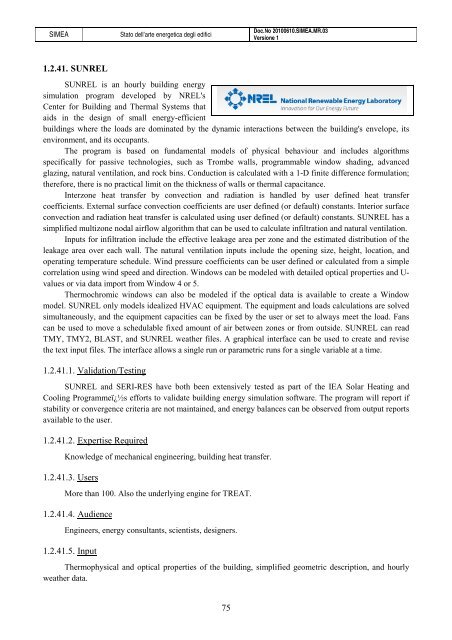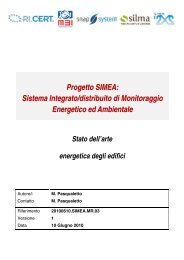Progetto SIMEA - Automatica - Università degli Studi di Padova
Progetto SIMEA - Automatica - Università degli Studi di Padova
Progetto SIMEA - Automatica - Università degli Studi di Padova
Create successful ePaper yourself
Turn your PDF publications into a flip-book with our unique Google optimized e-Paper software.
<strong>SIMEA</strong> Stato dell’arte energetica <strong>degli</strong> e<strong>di</strong>fici<br />
1.2.41. SUNREL<br />
75<br />
Doc.No 20100610.<strong>SIMEA</strong>.MR.03<br />
Versione 1<br />
SUNREL is an hourly buil<strong>di</strong>ng energy<br />
simulation program developed by NREL's<br />
Center for Buil<strong>di</strong>ng and Thermal Systems that<br />
aids in the design of small energy-efficient<br />
buil<strong>di</strong>ngs where the loads are dominated by the dynamic interactions between the buil<strong>di</strong>ng's envelope, its<br />
environment, and its occupants.<br />
The program is based on fundamental models of physical behaviour and includes algorithms<br />
specifically for passive technologies, such as Trombe walls, programmable window sha<strong>di</strong>ng, advanced<br />
glazing, natural ventilation, and rock bins. Conduction is calculated with a 1-D finite <strong>di</strong>fference formulation;<br />
therefore, there is no practical limit on the thickness of walls or thermal capacitance.<br />
Interzone heat transfer by convection and ra<strong>di</strong>ation is handled by user defined heat transfer<br />
coefficients. External surface convection coefficients are user defined (or default) constants. Interior surface<br />
convection and ra<strong>di</strong>ation heat transfer is calculated using user defined (or default) constants. SUNREL has a<br />
simplified multizone nodal airflow algorithm that can be used to calculate infiltration and natural ventilation.<br />
Inputs for infiltration include the effective leakage area per zone and the estimated <strong>di</strong>stribution of the<br />
leakage area over each wall. The natural ventilation inputs include the opening size, height, location, and<br />
operating temperature schedule. Wind pressure coefficients can be user defined or calculated from a simple<br />
correlation using wind speed and <strong>di</strong>rection. Windows can be modeled with detailed optical properties and Uvalues<br />
or via data import from Window 4 or 5.<br />
Thermochromic windows can also be modeled if the optical data is available to create a Window<br />
model. SUNREL only models idealized HVAC equipment. The equipment and loads calculations are solved<br />
simultaneously, and the equipment capacities can be fixed by the user or set to always meet the load. Fans<br />
can be used to move a schedulable fixed amount of air between zones or from outside. SUNREL can read<br />
TMY, TMY2, BLAST, and SUNREL weather files. A graphical interface can be used to create and revise<br />
the text input files. The interface allows a single run or parametric runs for a single variable at a time.<br />
1.2.41.1. Validation/Testing<br />
SUNREL and SERI-RES have both been extensively tested as part of the IEA Solar Heating and<br />
Cooling Programme�s efforts to validate buil<strong>di</strong>ng energy simulation software. The program will report if<br />
stability or convergence criteria are not maintained, and energy balances can be observed from output reports<br />
available to the user.<br />
1.2.41.2. Expertise Required<br />
Knowledge of mechanical engineering, buil<strong>di</strong>ng heat transfer.<br />
1.2.41.3. Users<br />
More than 100. Also the underlying engine for TREAT.<br />
1.2.41.4. Au<strong>di</strong>ence<br />
Engineers, energy consultants, scientists, designers.<br />
1.2.41.5. Input<br />
Thermophysical and optical properties of the buil<strong>di</strong>ng, simplified geometric description, and hourly<br />
weather data.
















